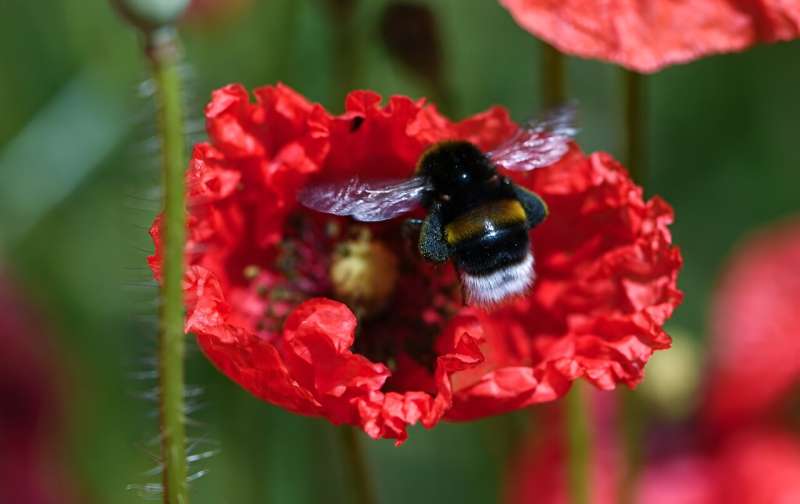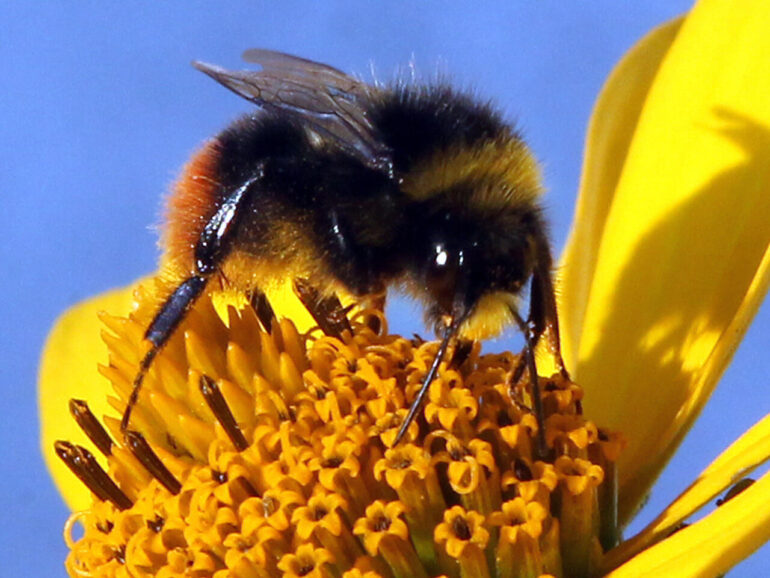Populations of European bumblebees are projected to fall drastically in the coming decades due to climate change and habitat loss, researchers warned on Wednesday.
Europe’s 68 species of bumblebees—including the fluffy, black-and-yellow striped ones often seen buzzing through gardens—play a crucial role in pollinating crops and wild plants.
But they are used to the cooler temperatures of the Northern Hemisphere, and a warming world caused by human-caused climate change is putting them increasingly under threat, according to the study in the journal Nature.
A team of Belgian researchers collected data on 46 bumblebee species across Europe, assessing the past (1901-1970) and present 2001-2014), comprising more than 400,000 different observations.
They combined this data with the latest modeling from the UN’s IPCC climate change panel as well as predictions of changes in land use.
Under the worst-case scenario, they found that “up to 75 percent of bumblebee species which are not currently threatened will see their distribution area shrink 30 percent by 2061-2080,” lead author Guillaume Ghisbain of the Universite Libre de Bruxelles told AFP.
This means that most of the European bumblebees currently classified as of “least concern” on the IUCN’s list of threatened species could fall into the endangered category.
Bumblebee species in Arctic or alpine environments may even be pushed to the edge of extinction, with an expected loss of 90 percent of their habitat.
There was also bad news for the most common of Europe’s bumblebees, Bombus terrestris, a plump bee often spotted pollinating flowers in backyards.
By 2080, it “would see the limit of its geographical distribution, which currently borders the Sahara Desert, pull back to the Loire Valley” in central France, said co-author Pierre Rasmont of the University of Mons.

Bumblebees are particularly sensitive to heat, dying off when temperatures get too high.
Sensitive to heat
Part of the expected decline was due to how land is expected to be used in the next half century.
“Intensive agriculture fragments habitats and relies on synthetic fertilizers which artificially enrich the soil with nitrogen,” Ghisbain said.
“However, bumblebees mainly consume plants which grow in soil poor in nitrogen,” such as clover, he added.
Repeated droughts, made more frequent and severe by climate change, also kill off the plants eaten by bumblebees.
But heat waves intensified by global warming pose an even bigger threat. Apart from a few resistant species, bumblebees are particularly sensitive to heat.
“We observed this in our laboratory one day when the air conditioning broke down—it was 40 degrees Celsius (104 Fahrenheit) and our colonies died in less than an hour,” Rasmont said.
“Some survive, but their sperm becomes deficient.”
The researchers suggested that some bees could seek refuge in the cooler climes of Scandinavia.
They have even spotted a few industrious bees who have already made the trek north.
“One day I was collecting bumblebees in northern Norway and suddenly, among the Arctic species, I came across a Bombus terrestris,” Rasmont said.
“It had leapt 800 kilometers (500 miles) north” of its natural habitat, he added.
More information:
Guillaume Ghisbain et al, Projected decline in European bumblebee populations in the twenty-first century, Nature (2023). DOI: 10.1038/s41586-023-06471-0
2023 AFP
Citation:
European bumblebee populations projected to plummet (2023, September 13)



